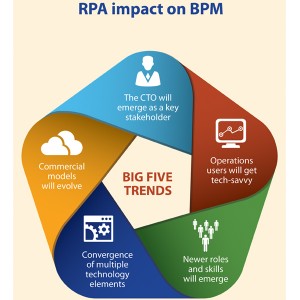
source: forbesindia.com
Five Trends That May Emerge As BPM Automation Increases
Technology has transformed the functionality of our phones, watches, TV and other devices, changing the way we live. This transformation—in people and the environment—has made it imperative for enterprises to adapt to these changes or perish.
Transformation through technology and automation is not new. In the manufacturing industry, robots have been handling most repeatable tasks and human intervention has been limited to controlling, coordinating and decision-making.
In the Business Process Management (BPM) sector too, automation and macros have always been a part of operations. Several advanced transformational point solutions (or bolt-on solutions) have also resided alongside Enterprise Resource Planning (ERPs) and other business applications. However, much has changed, especially expectations. BPM is now expected to move up the ladder and automate as much repeatable and manual (rule-based) tasks with software bots, as possible. Such a transformation will surely be gradual but steady and will depend on the maturity, commitment and willingness of client organisations.
As the industry undergoes this critical phase, operations models will evolve. Expect adjustments and changes made by both clients and service providers to adapt and embrace automation. Key trends that are expected to unfold are:
1. The CTO will emerge as a key stakeholder
The role of a customer CTO is usually limited to supporting the BPM initiative. However, when more and more technology solutions are rolled-out, mobility, robotics and automation will become the key tenets of the BPM engagement giving rise to more technical challenges.
In a traditional BPM engagement, the CTO supports only basic infrastructure needs such as extending the network, providing user access, hosting applications and more. The existing landscape and applications are, to a large extent, untouched or under the control of the IT organisation. However, once mobility, robots, phantom users and automation are introduced, technology interventions will be needed in the existing landscape. These will require reviews and approvals both from the technology and security teams. In future, the CTO and the CIO will have larger roles to play and will be important stakeholders. They will have to review the impact on existing IT support and processes, the existing application landscape and, most importantly, check if it aligns with the organisational IT and security policy.
2. Operations users will get tech-savvy
Another obvious impact would be that the operations team will begin working more and more in a technology-driven operations environment. More and more process improvement opportunities will be driven by automation and operations users would need to start thinking of making these robots more efficient and effective. The team would need to constantly look for ways to adopt automation in various processes with process efficiencies being a measure of the extent of ‘touchless processing’.
3. Newer roles and skills will emerge
Skill enhancement will happen at an agent level. Work performed by agents will require human judgement and special skills, as most of the rule-based, mundane activities would have moved to robots.
Newer roles will therefore evolve to support and manage a technology-driven environment. There will be specialised roles that require domain and process expertise to innovate and manage the automated process and techno-functional roles to support automation. Drawing a corollary from manufacturing on the shop floor of an automated manufacturing setup, humans manage and control physical robots. This will be essential in the BPM environment and each operations floor will need a mechanism for switching the programs on and off, and using them on a need basis.
4. Convergence of multiple technology elements
Artificial intelligence, analytics, mobility, automation, cloud and automation solutions will have to work with each other and with other mainstream applications and ERPs. This would mean more complex interoperability and data exchange with some of these solutions converging into one bundle.
The wheels of some of these changes are already in motion. Many point solutions (such as accounts-payable solutions) are on the cloud and are embedding elements of analytics and automation into their offering. This trend will continue and we will see more elements of seamless interoperability and convergence between applications.
5. Commercial models will evolve
Tomorrow’s BPM will not be based on a mere number of transactions but on amplification of business value, innovative service delivery and capability for ‘touchless processing’.
As the whole concept of automation and cognitive computing gains traction and becomes clearer, know that change will not happen overnight. It will be a few years before it becomes the norm. BPM organisations that can envision and anticipate these changes and adapt will eventually have the edge. But the clear winner will be the customer with better business outcomes, cost-effectiveness, and data and cost transparency.
Source: forbesindia.com by Santosh Unni, Sr. Director – Technology and Automation Practice
Read more: http://forbesindia.com/blog/business-strategy/five-trends-that-may-emerge-as-automation-increases-in-bpm-sector/#ixzz3uEYH9QT0
